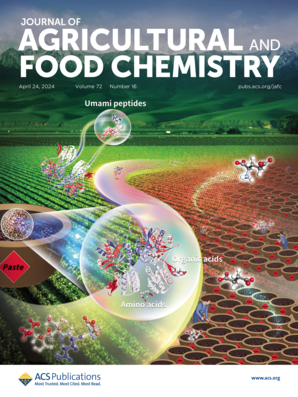1,8 -桉树脑通过调节TRP-KYN和精氨酸- no重编程改善金黄色葡萄球菌诱导的肺炎
IF 5.7
1区 农林科学
Q1 AGRICULTURE, MULTIDISCIPLINARY
引用次数: 0
摘要
1,8 -桉树脑(Cin)是一种从茶树和桉树中提取的环单萜类化合物,具有多种药理特性。然而,其治疗金黄色葡萄球菌(S. aureus)肺炎的作用和潜在机制仍有待阐明。本研究将基于UPLC-MS/MS的代谢组学技术与网络药理学、分子生物学、分子对接技术相结合,对Cin的作用进行研究。结果表明,Cin可显著降低感染小鼠的死亡率和肺细菌负荷,减轻肺损伤,同时抑制支气管肺泡灌洗液(BALF)中促炎因子,包括肿瘤坏死因子α (TNF-α)、白细胞介素-1β (IL-1β)和白细胞介素-6 (IL-6)的水平。此外,主要参与色氨酸代谢和精氨酸生物合成的19种代谢物,通过抑制吲哚胺2,3 -双加氧酶1 (IDO1)和诱导型一氧化氮合酶(iNOS)的酶活性而被Cin显著修饰,从而减轻炎症反应。值得注意的是,IDO1或iNOS的下调显著降低了Cin的抗炎作用。综上所述,我们的研究证实了Cin通过下调IDO1和iNOS抗炎症来治疗金黄色葡萄球菌肺炎的潜力。本研究结果为天然物质在细菌性肺炎治疗中的应用提供了理论依据。本文章由计算机程序翻译,如有差异,请以英文原文为准。

1, 8-Cineole Ameliorated Staphylococcus aureus-Induced Pneumonia through Modulation of TRP-KYN and Arginine-NO Reprogramming
1, 8-Cineole (Cin), a cyclic monoterpenoid derived from tea trees and eucalyptus species, exhibits diverse pharmacological properties. Yet, its therapeutic impact and underlying mechanism against Staphylococcus aureus (S. aureus) pneumonia remain to be elucidated. In this study, metabolomics based on UPLC-MS/MS was integrated with network pharmacology, molecular biology, and molecular docking to investigate the effects of Cin. The findings demonstrated that Cin markedly reduced mortality and lung bacterial load, lessened pulmonary damage while suppressing the levels of proinflammatory factors, including tumor necrosis factor α (TNF-α), interleukin-1β (IL-1β), and interleukin-6 (IL-6) in the bronchoalveolar lavage fluid (BALF) of infected mice. Additionally, 19 metabolites, primarily involved in tryptophan metabolism and arginine biosynthesis, were notably modified by Cin via suppressing the enzymatic activity of indoleamine 2, 3-dioxygenase 1 (IDO1) and inducible nitric oxide synthase (iNOS), thereby attenuating the inflammatory response. Notably, knockdown of IDO1 or iNOS significantly diminished the anti-inflammation effect of Cin. In conclusion, our study validates the therapeutic potential of Cin against S. aureus pneumonia via anti-inflammation by downregulating IDO1 and iNOS. Our results provide a theoretical basis of natural substances applied in bacterial pneumonia treatment.
求助全文
通过发布文献求助,成功后即可免费获取论文全文。
去求助
来源期刊
CiteScore
9.90
自引率
8.20%
发文量
1375
审稿时长
2.3 months
期刊介绍:
The Journal of Agricultural and Food Chemistry publishes high-quality, cutting edge original research representing complete studies and research advances dealing with the chemistry and biochemistry of agriculture and food. The Journal also encourages papers with chemistry and/or biochemistry as a major component combined with biological/sensory/nutritional/toxicological evaluation related to agriculture and/or food.

 求助内容:
求助内容: 应助结果提醒方式:
应助结果提醒方式:


